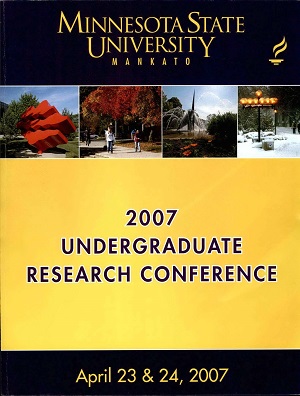The Morphological Changes in the Intestine of the Earthworm (Eisenia Foetida) After Treatment of Antibiotics
Location
CSU 253/4/5
Start Date
24-4-2007 10:30 AM
End Date
24-4-2007 12:30 PM
Student's Major
Biological Sciences
Student's College
Science, Engineering and Technology
Mentor's Name
Michael Bentley
Mentor's Department
Biological Sciences
Mentor's College
Science, Engineering and Technology
Description
Earthworms thrive in a microbial rich environment. However, the nature of the defense microbial mechanisms in regards to the intestinal tract is poorly understood. The purpose of this study is to determine whether the morphology of the digestive tract is altered with the presence or absence of bacteria. The digestive tracts of six normal earthworms were compared to the digestive tract of six worms treated with antibiotics (penicillin, streptomycin, and actinomycin D). Each worm was anesthetized with 5% ethanol and then cut into nine segments. The intestine was isolated from each segment and fixed in 3% glutaraldehyde and post fixed in osmium tetroxide. The tissues were then dehydrated in graded acetone solutions, critical point, and sputter coated with gold and palladium for examination with the scanning electron microscope. Epithelial cells tapered to basal processes which appeared to fit into socket-like depressions in the basal lamina. Also, a brush border of microvilli was seen and continued with highly ridged lateral epithelial cell surface; currently, no clear-cut distinctions have been observed between the antibiotic-treated and normal earthworms. These results indicate that there are differences in size and appearance of antibiotic-treated and normal earthworms, the intestinal tracts appear similar.
The Morphological Changes in the Intestine of the Earthworm (Eisenia Foetida) After Treatment of Antibiotics
CSU 253/4/5
Earthworms thrive in a microbial rich environment. However, the nature of the defense microbial mechanisms in regards to the intestinal tract is poorly understood. The purpose of this study is to determine whether the morphology of the digestive tract is altered with the presence or absence of bacteria. The digestive tracts of six normal earthworms were compared to the digestive tract of six worms treated with antibiotics (penicillin, streptomycin, and actinomycin D). Each worm was anesthetized with 5% ethanol and then cut into nine segments. The intestine was isolated from each segment and fixed in 3% glutaraldehyde and post fixed in osmium tetroxide. The tissues were then dehydrated in graded acetone solutions, critical point, and sputter coated with gold and palladium for examination with the scanning electron microscope. Epithelial cells tapered to basal processes which appeared to fit into socket-like depressions in the basal lamina. Also, a brush border of microvilli was seen and continued with highly ridged lateral epithelial cell surface; currently, no clear-cut distinctions have been observed between the antibiotic-treated and normal earthworms. These results indicate that there are differences in size and appearance of antibiotic-treated and normal earthworms, the intestinal tracts appear similar.
Recommended Citation
Brueske, Alicia and Emma Boyce. "The Morphological Changes in the Intestine of the Earthworm (Eisenia Foetida) After Treatment of Antibiotics." Undergraduate Research Symposium, Mankato, MN, April 24, 2007.
https://cornerstone.lib.mnsu.edu/urs/2007/poster-session-C/8



